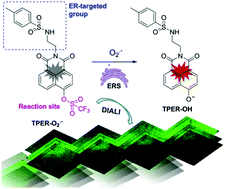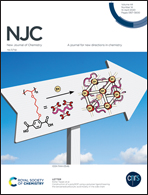Imaging of endoplasmic reticulum superoxide anion fluctuation in a liver injury model by a selective two-photon fluorescent probe†
Abstract
The superoxide anion (O2˙−), with strong oxidizability and nucleophilicity, is the primary reactive oxygen species in living systems, and the overformation of O2˙− is associated with many physiological and pathological diseases. Therefore, highly sensitive and selective O2˙− detection is necessary for exploring its roles in disease situations. In this work, we presented a smart ER-targeted two-photon excitation fluorescent O2˙− probe, named TPER-O2˙−, based on the caged–decaged method of characteristic hydroxyl groups on fluorophores. The TPER-O2˙− probe, with good sensitivity (detection limit: 0.33 μM) and excellent selectivity for O2˙−, was applied for the detection of endogenous endoplasmic reticulum O2˙− in HepG2 cells. Furthermore, it was also successfully applied to image the endoplasmic reticulum O2˙− level fluctuation in an APAP-stimulated liver injury model. The TPER-O2˙− probe has been demonstrated to be a potential tool to unmask the role of O2˙− for endoplasmic reticulum stress-relevant clinical diseases.



 Please wait while we load your content...
Please wait while we load your content...